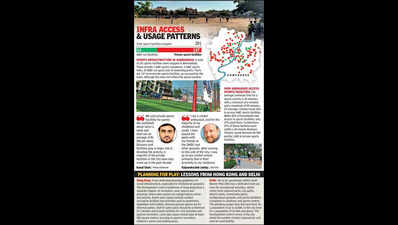- News
- City News
- ahmedabad News
- Amdavadis travel 24 mins on average to access sports facilities: CEPT study
Trending
Amdavadis travel 24 mins on average to access sports facilities: CEPT study
Ahmedabad: For Dheeraj Trivedi, a resident of Satellite, travelling 13km to a cricket ground near Telav, off SP Ring Road, has become a Sunday ritual. "It takes me around 25 minutes to reach the place. While GMDC Grounds and the one near Shyamal crossroads were our favourite haunts a few years ago, better facilities motivated us to shift venues. While many children still play cricket on the streets, there are now fewer larger grounds now for casual games," he says.
A recent study by CEPT University students Mehar Kalra and Priyal Sethia, reflecting these sentiments, won an award in Madhya Pradesh. Titled ‘Inclusive sports for all: Transforming infrastructure for accessibility', the study found that Ahmedabad residents travel an average of 24 minutes to reach sports facilities, with travel times ranging from 2 to 95 minutes. The team was mentored by Prof Saswat Bandopadhyay.
You Can Also Check: Ahmedabad AQI | Weather in Ahmedabad | Bank Holidays in Ahmedabad | Public Holidays in Ahmedabad
"We aimed to understand the availability of public and private sports facilities in the city and found that there is a significant room for improvement in public infrastructure. Most new sports facilities are developing beyond SG Road and SP Ring Road due to the availability of open plots that can be converted into gaming arenas," Kalra told TOI.
The researchers surveyed 450 houses, conducted 10 informant interviews and three focused group discussions for the study.
Their findings revealed that residents near the AMC periphery typically travel more than 3 km to access the facilities. While 45% of households had access to sports facilities, only 27% actually used them, the study mentions.
Costs remain a key factor: public facilities charge Rs 100-600 per month for a range of activities including working out at the gyms to playing turf football.
In comparison, citizens shell out upwards of 600 per hour for some of the popular games in private facilities. Since not everyone can afford the high costs, several communities have converted vacant plots into makeshift playgrounds, the researchers said.
The study recommends developing open spaces and play facilities at all levels — from neighbourbood blocks to city-wide infrastructure — to encourage physical activity. For neighbourhoods with populations up to 15,000, a 400-metre buffer zone is suggested, while ward and zone levels should have community sports centres and multipurpose grass pitches. For a city like Ahmedabad, which aspires to host the 2036 Olympics, the researchers propose establishing zonal sports centres and open spaces up to 10 hectares in size.
Ahmedabad: For Dheeraj Trivedi, a resident of Satellite, travelling 13km to a cricket ground near Telav, off SP Ring Road, has become a Sunday ritual. "It takes me around 25 minutes to reach the place. While GMDC Grounds and the one near Shyamal crossroads were our favourite haunts a few years ago, better facilities motivated us to shift venues. While many children still play cricket on the streets, there are now fewer larger grounds now for casual games," he says.
A recent study by CEPT University students Mehar Kalra and Priyal Sethia, reflecting these sentiments, won an award in Madhya Pradesh. Titled ‘Inclusive sports for all: Transforming infrastructure for accessibility', the study found that Ahmedabad residents travel an average of 24 minutes to reach sports facilities, with travel times ranging from 2 to 95 minutes. The team was mentored by Prof Saswat Bandopadhyay.
"We aimed to understand the availability of public and private sports facilities in the city and found that there is a significant room for improvement in public infrastructure. Most new sports facilities are developing beyond SG Road and SP Ring Road due to the availability of open plots that can be converted into gaming arenas," Kalra told TOI.
She added that some schools without dedicated playgrounds have been taking their students to several sports facilities that have come up under the PPP model.
The researchers surveyed 450 houses, conducted 10 informant interviews and three focused group discussions for the study.
Their findings revealed that residents near the AMC periphery typically travel more than 3 km to access the facilities. While 45% of households had access to sports facilities, only 27% actually used them, the study mentions.
Costs remain a key factor: public facilities charge Rs 100-600 per month for a range of activities including working out at the gyms to playing turf football.
In comparison, citizens shell out upwards of 600 per hour for some of the popular games in private facilities. Since not everyone can afford the high costs, several communities have converted vacant plots into makeshift playgrounds, the researchers said.
The study recommends developing open spaces and play facilities at all levels — from neighbourbood blocks to city-wide infrastructure — to encourage physical activity. For neighbourhoods with populations up to 15,000, a 400-metre buffer zone is suggested, while ward and zone levels should have community sports centres and multipurpose grass pitches. For a city like Ahmedabad, which aspires to host the 2036 Olympics, the researchers propose establishing zonal sports centres and open spaces up to 10 hectares in size.

About the Author
Parth ShastriEnd of Article
Follow Us On Social Media









